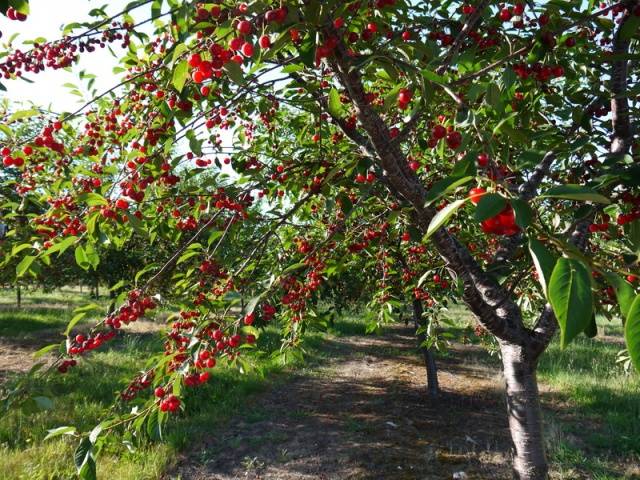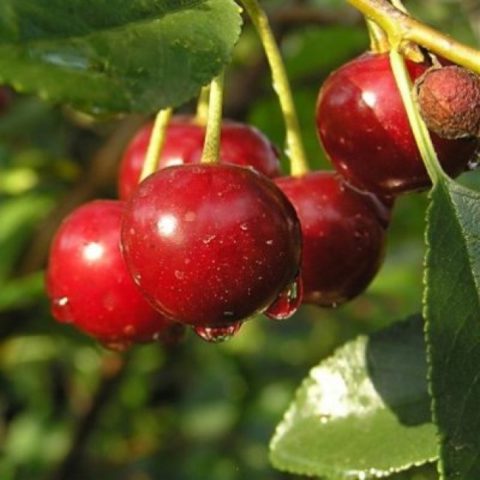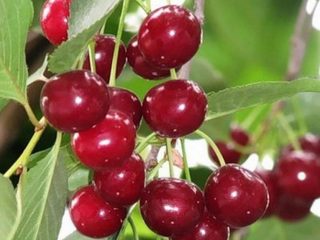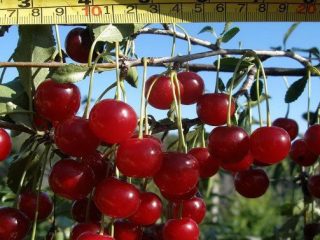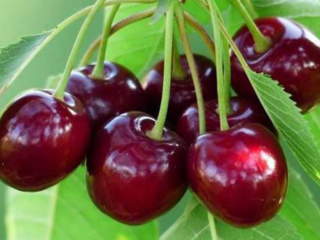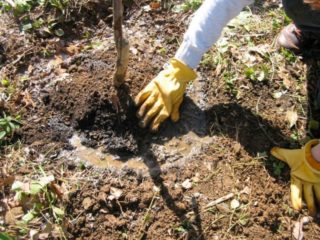Content
Cherry Brunetka is a versatile variety that is appreciated by gardeners for its excellent taste, frost resistance and high yield. In order for a fruit tree to bring a consistently high yield every year, it is necessary to follow the rules for planting and caring for this crop.
Description Cherry Brunette
Cherry Brunetka is a small, medium-sized tree with a spreading spherical crown of medium density and rounded maroon fruits.
This crop is recommended for cultivation in the Central and Southern regions of Russia.
Variety of cherry ordinary Brunetka (Prunus Cerasus Bryunetka) was bred at the All-Russian Institute of Selection and Technology for Horticulture and Nursery as a result of sowing seeds obtained from free pollination of the Zhukovskaya variety. In 1995, the species of cherry Brunetka was accepted for state variety testing, and in 2001 it was included in the State Register for the Central Region.
Height and dimensions of an adult tree
The height of an adult tree is about 2-2.5 m (sometimes up to 3 m). The crown of this culture is not very dense, spreading, has a spherical shape. Cherry foliage is colored dark green. The leaves are oblong, medium in size, the edges of the plate are serrated. Umbellate inflorescences with white flowers and a pleasant pronounced aroma.
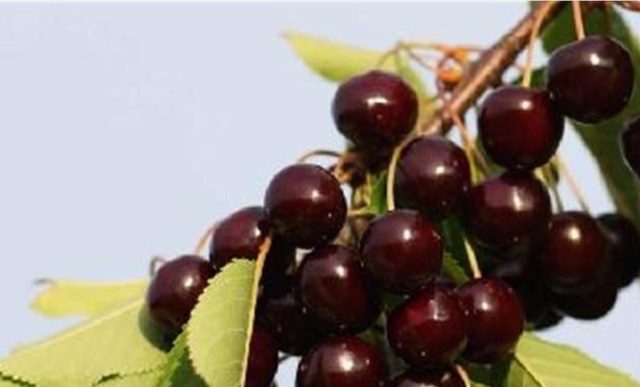
Despite the small size of the tree, the fruits of this culture are quite large in weight and excellent tasting properties.
Description of fruits
Cherry berries Brunettes have:
- rounded slightly flattened shape;
- maroon skin;
- red pulp with a delicate texture;
- easily detachable small oval bone;
- pleasant sweet taste with a slight sourness.
The average weight of the berries of this culture is 3-4 g. Fruits ripen by the end of July. Due to the fact that this variety is self-pollinated, the fruits are formed every year on last year's increments. The application is universal.
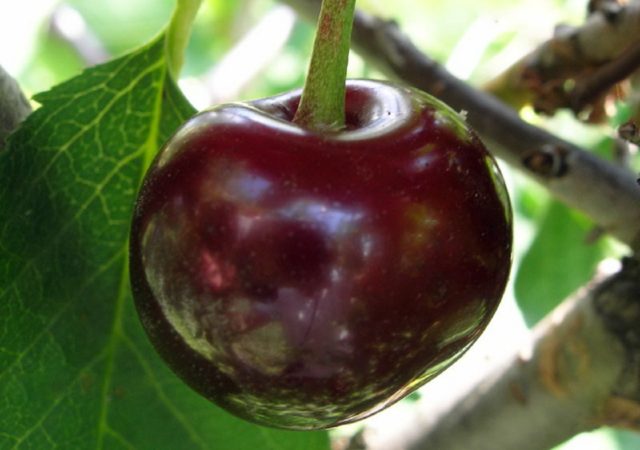
The fruit of the tree is appreciated for its tender and juicy pulp.
Cherry pollinators Brunette
Cherry Brunetka is a self-fertile plant that does not need additional pollinators. However, the presence of a number of crops of other varieties allows you to increase the yield of the tree.
As pollinators for cherries, Brunettes use varieties:
- Vladimirskaya;
- In memory of Yenikeev.
Main characteristics
Cherry Brunetka is popular for its excellent characteristics, productivity, drought resistance and frost resistance. However, like any variety, the Brunette has its own advantages and disadvantages.
Drought resistance, frost resistance
This cherry variety tolerates drought well. It is necessary to water the plant during the periods:
- ovary formation;
- flowering;
- leaf fall.
Winter hardiness of Brunettes cherries is average. Flower buds are sensitive to severe spring frosts.
Yield
The tree begins to bear fruit 3-4 years after planting. The average yield of one tree per year is about 10-12 kg or 8-9 t / ha (after four years). The indicator depends on the quality of care and climatic conditions.
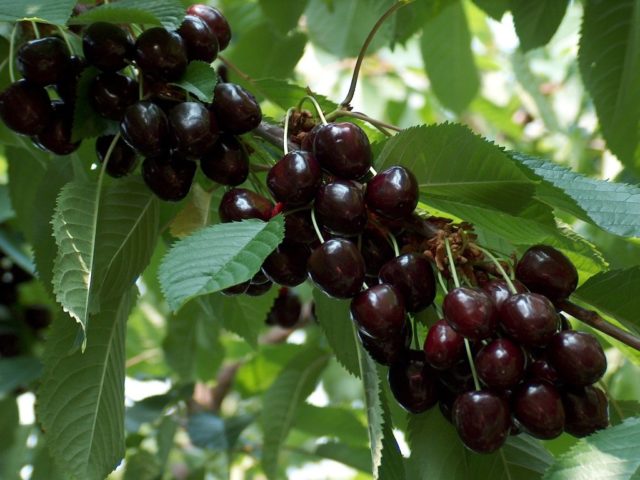
Cherry Brunette is considered a fast-growing crop
Advantages and disadvantages
Of the advantages of this variety, Russian gardeners note:
- frost resistance;
- good drought tolerance;
- high productivity;
- average ripening period of fruits;
- ripe berries do not crumble, do not crack or rot.
The disadvantages of this variety include:
- medium resistance of flower buds to low temperatures;
- susceptibility to fungal diseases.
Landing rules
Before planting a crop, you need to choose a place and determine the timing. It is also worth considering the rules for planting a culture.
Recommended timing
In the southern regions, planting must be carried out in the autumn, in the middle lane it is most effective to do this in the first half of September. In areas with a harsh climate, it is advisable to plant Brunetka cherries in the spring, since there is a high risk of freezing of young seedlings.
Site selection and soil preparation
The best place for planting Brunetka cherries is considered to be a place on a not very steep slope. When choosing, it must be borne in mind that this tree loves a lot of sunlight.
The soil for planting a seedling must meet the following requirements:
- neutral acidity pH = 6.5-7;
- balanced content of sand and clay;
- good air exchange;
- drainage layer.
The preparation of the seedling pit must be started two weeks before planting:
- size: 40 cm - depth, 60 cm - diameter (the volume of the root system of the seedling should be taken into account);
- soil preparation: mixing with fertilizers;
- placing a peg in the planting pit;
- laying the treated soil into the pit.
To prepare the ideal soil for cherries, you need to mix it with organic compounds (manure, compost), fertilizers (potash, phosphate).

If planting plants are planned on acidic soils, it is necessary to prepare the land by adding lime to the substrate.
How to plant correctly
The correct planting of a cherry seedling should be carried out as follows:
- Dig a hole in a prepared place.
- Straighten the roots and process them with garden varnish.
- Place the seedling at the bottom of the pit, while adding soil (the root collar should be 57 cm above the ground);
- Tie the stem of the seedling to the peg.
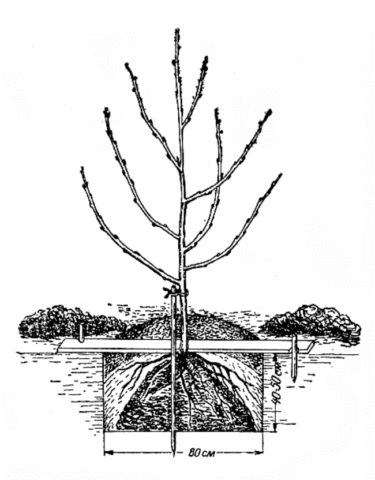
Scheme of the correct planting of cherry seedlings
After completing the procedure, it is necessary to water the soil abundantly (about 3 liters of water), having previously created an artificial embankment around the seedling.
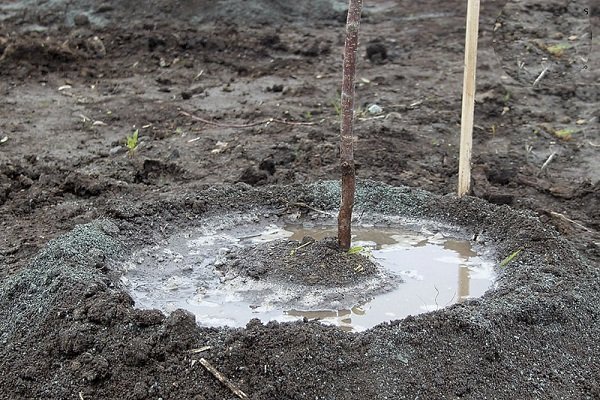
After watering, it is advisable to mulch the soil near the seedling
Care features
Cherry Brunette is unpretentious in care. However, in order to maintain high yields and increase the life cycle of the plant, certain rules must be adhered to.
Watering and feeding schedule
This cherry variety tolerates drought well. It is necessary to water the plant during the period of ovary formation, flowering and leaf fall. Approximately 3 liters of water per plant will be sufficient. In areas with frequent dry weather, additional watering is required. A month before harvesting, it is stopped, otherwise it can cause rotting, and negatively affect the taste of the fruit.
As a plant feeding, it is necessary to use fertilizers, which include:
- potassium;
- phosphorus;
- nitrogen (can not be used for planting, only in the spring in small quantities).
For the intensive growth and development of the Brunettes cherries, you must adhere to the feeding schedule. The first is applied at planting, the next - not earlier than 2-3 years later in two stages:
- at the end of the flowering period;
- two weeks after the first feeding.
As fertilizers, it is advisable to use a mixture of urea, potassium chloride and superphosphate. After that, the cherries need to be watered (about 10-15 liters of water per tree).
Pruning
The spreading crown of this medium-sized culture requires regular formation. Branches located below 40-50 cm from ground level are subject to pruning. Such a procedure will increase the yield, the duration of the life cycle of the crop. First of all, dry and deprived branches are removed.
The formation of the Brunettes cherries must be carried out within 2-4 years.
Preparing for winter
Preparation of Brunettes cherries for winter, like other varieties of this culture, must be done before the onset of the first frost. In regions with a mild climate and snowy winters, it is enough to treat the soil with fertilizers and carry out the final watering. In regions with harsh climates, the tree should be prepared differently for wintering, which includes:
- sanitary pruning of branches;
- tillage around the trunk (near-trunk circle);
- watering and mulching the soil;
- whitewashing the trunk;
- pest control.
Cherries should be covered in October.
Diseases and pests
Cherry vulgaris Brunetka is resistant to most diseases. However, with inadequate care, this variety is susceptible to fungal and bacterial diseases.
Anthracnose - a fungal disease, the development of which is favored by increased importance (more than 90%). The skin of the fruit is covered with small bumps with a pinkish bloom, which dry out when the weather is warm.

In the fight against the disease, treatment with fungicides and the removal of affected tree fruits helps.
Hommosis, or gum flow, manifested by the flow of gum (sticky substance) from the tree trunk and branches. It occurs as a side effect of diseases or poor quality crop care.
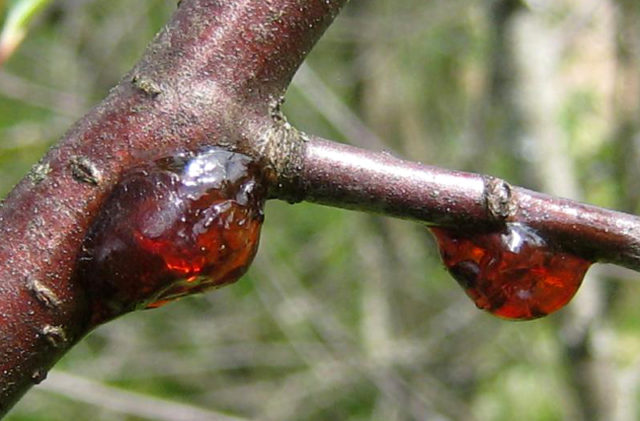
With gommosis, the trunk and branches of the tree are treated with copper sulfate and garden varnish, and the damaged branches are cut off
Hole spotting, or klyasterosporiosis, occurs when the conditions for growing crops (temperature, humidity) are violated. If signs of disease are found, the culture must be treated with Bordeaux liquid, and the affected areas removed.
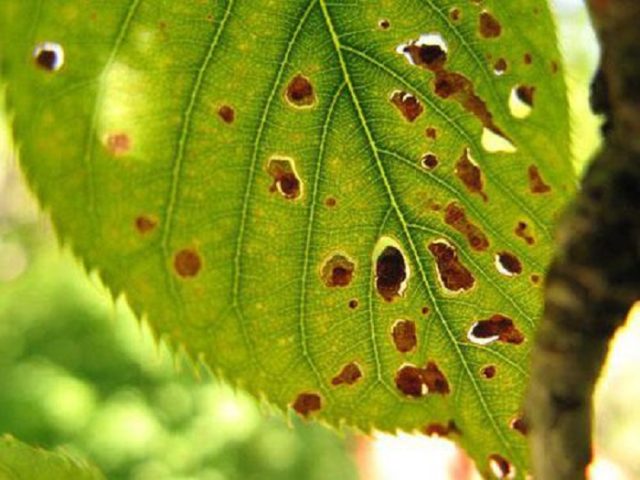
A fungal disease affects the leaves and fruits of the tree - brown spots and holes appear
The greatest danger to cherry cherries are the following pests:
- cherry aphid;
- cherry weevil (larvae and adult insects);
- slimy sawfly (larvae);
- caterpillars of the shoot moth.
Conclusion
Cherry Brunetka is a versatile and rather unpretentious fruit crop variety. It will produce high yields for many years. To do this, it is necessary to follow the rules for planting seedlings, caring for a tree and timely carry out agrotechnical measures.
Testimonials
Anna Pavlova, 47 years old, Kaluga
